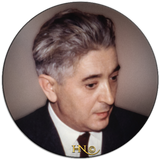Linocuts
A relief printmaking technique similar to the woodcut, where the non-printing areas are carved or chiseled away with a u or v-shaped gouge. Linoleum is preferred over wood when larger flat black and white areas are needed, and when the intricacy of hard wood is not required. After the linoleum block is carved, raised areas are inked and printed either by the "hand and spoon" method or with a hand printing press. Hnizdovsky often used linoleum for his larger black and white prints, as well as for his large color prints. The quality of line is more rounded, whereas the quality of the woodcut line can be seen as more jagged and sharp. Linoleum can often be seen as more forgiving. The intricate details that are possible with wood are also very delicate and easily chip, and can become well worn after an edition is printed, sometimes before an edition is even completed. For this reason, many woodcut editions may be smaller than originally planned. Additionally, wood is porous and often warps as a result of the moisture content contained in ink. Linoleum allows a larger, flatter and more stable non-porous surface, less at risk of warping.
























